Business Economics BUECO5903 Semester 1 Macroeconomics Assignment
VerifiedAdded on 2022/11/25
|14
|2713
|386
Homework Assignment
AI Summary
This assignment solution addresses key macroeconomic concepts, including demand-pull and cost-push inflation, causes of inflation, and the advantages and disadvantages of using the Consumer Price Index (CPI) to measure prices. The document explains the impact of various factors, such as future expectations of inflation, monetary policy over-expansion, and changes in factor input costs, on inflation. It also discusses the effects of government policies and external factors like exports and capital stock destruction on economic activity. Furthermore, the assignment explores the relationship between interest rates, government spending, and money supply, providing a comprehensive overview of macroeconomic principles. The solution also analyzes the impact of inflation on various economic actors, such as lenders and borrowers.
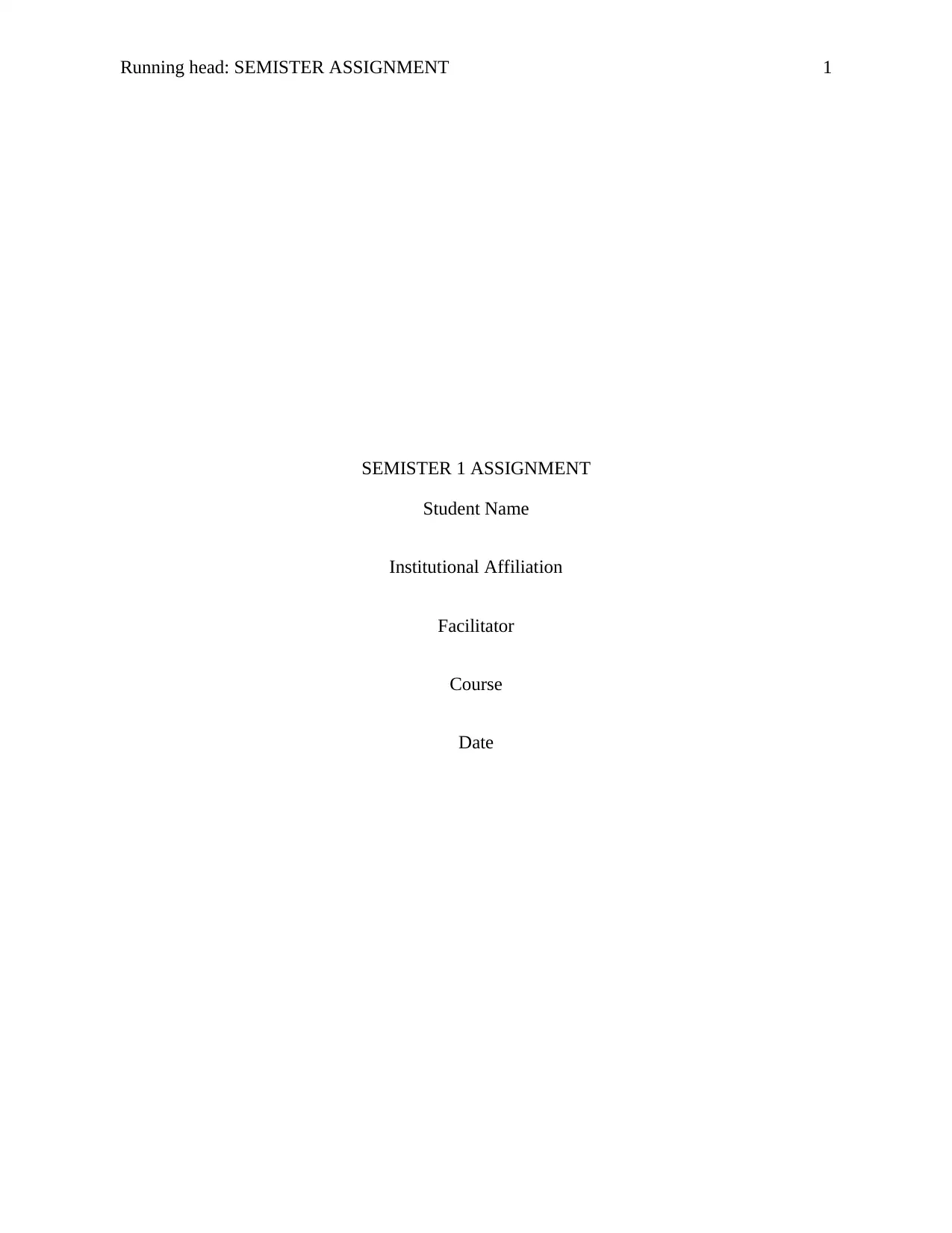
Running head: SEMISTER ASSIGNMENT 1
SEMISTER 1 ASSIGNMENT
Student Name
Institutional Affiliation
Facilitator
Course
Date
SEMISTER 1 ASSIGNMENT
Student Name
Institutional Affiliation
Facilitator
Course
Date
Paraphrase This Document
Need a fresh take? Get an instant paraphrase of this document with our AI Paraphraser

SEMISTER 1 ASSIGNMENT 2
Question3
a.
Demand-pull Inflation
An increase in the aggregate demand will cause demand-pull inflation. This means that
demand-pull inflation occurs in the economy when aggregate demand increases more than the
aggregate supply (Dmitrieva & Ushakov, 2011). This scenario occurs when too much money in
an economy chases few goods and services available which cannot meet consumer demand
sufficiently. As this inflation occurs, the economy grows on the other hand and hence
unemployment in the economy declines. This is because producers produce more goods and
services when demand increases in an attempt to meet the high consumer demand. The increase
in productivity involves the employment of more workers in order to participate in extra
productivity to meet the increased demand. However, producers reach an optimal point in their
production whereby they can’t produce more goods and services as more productivity becomes
less profitable. This means that they reduce their production to avoid losses arising from
increased production and hence aggregate demand exceeds aggregate supply. Suppliers,
therefore, increase prices for their goods and services as supply is outstripped by demand. This
rise in prices causes demand-pull inflation. The following diagram is used to explain this
scenario.
Question3
a.
Demand-pull Inflation
An increase in the aggregate demand will cause demand-pull inflation. This means that
demand-pull inflation occurs in the economy when aggregate demand increases more than the
aggregate supply (Dmitrieva & Ushakov, 2011). This scenario occurs when too much money in
an economy chases few goods and services available which cannot meet consumer demand
sufficiently. As this inflation occurs, the economy grows on the other hand and hence
unemployment in the economy declines. This is because producers produce more goods and
services when demand increases in an attempt to meet the high consumer demand. The increase
in productivity involves the employment of more workers in order to participate in extra
productivity to meet the increased demand. However, producers reach an optimal point in their
production whereby they can’t produce more goods and services as more productivity becomes
less profitable. This means that they reduce their production to avoid losses arising from
increased production and hence aggregate demand exceeds aggregate supply. Suppliers,
therefore, increase prices for their goods and services as supply is outstripped by demand. This
rise in prices causes demand-pull inflation. The following diagram is used to explain this
scenario.
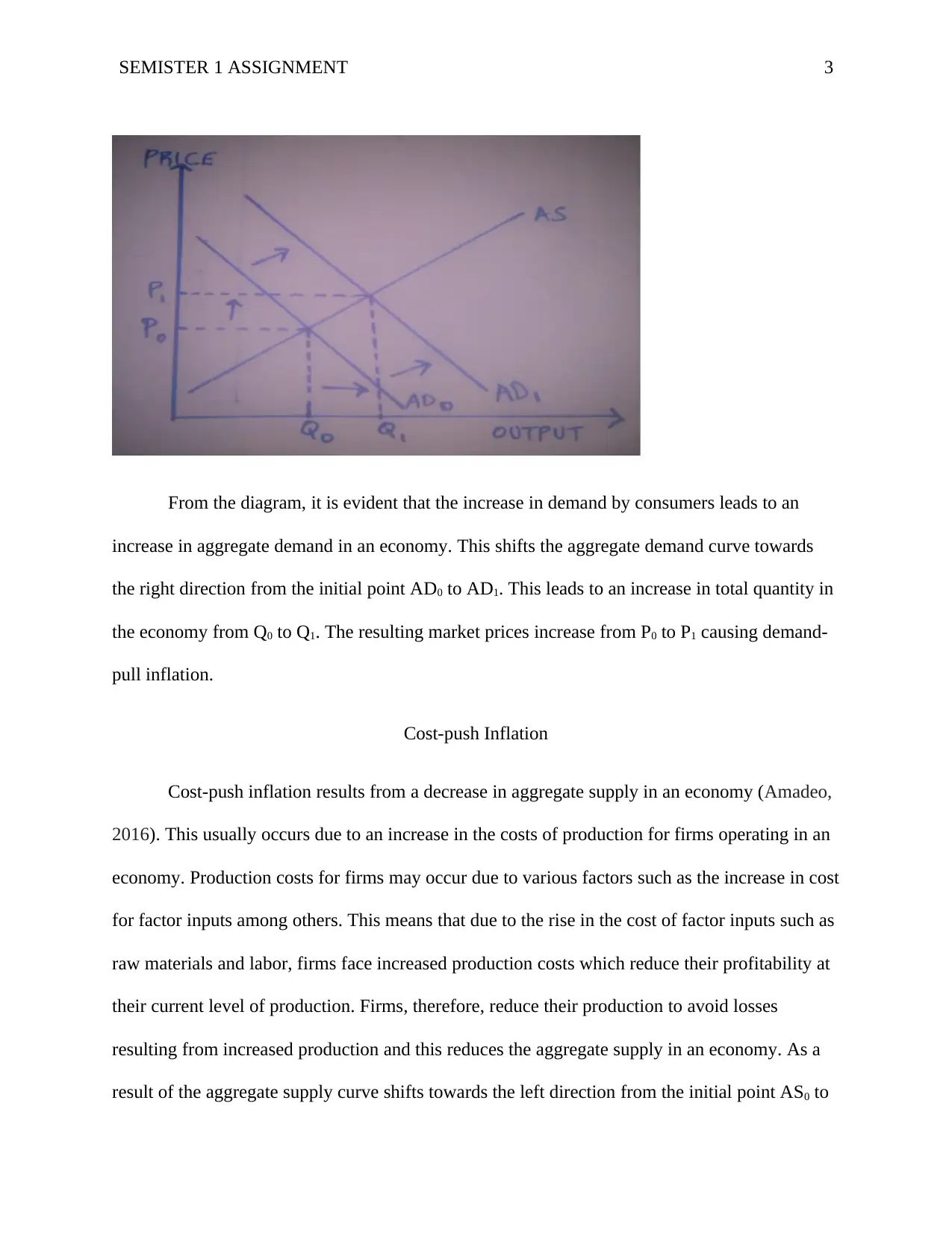
SEMISTER 1 ASSIGNMENT 3
From the diagram, it is evident that the increase in demand by consumers leads to an
increase in aggregate demand in an economy. This shifts the aggregate demand curve towards
the right direction from the initial point AD0 to AD1. This leads to an increase in total quantity in
the economy from Q0 to Q1. The resulting market prices increase from P0 to P1 causing demand-
pull inflation.
Cost-push Inflation
Cost-push inflation results from a decrease in aggregate supply in an economy (Amadeo,
2016). This usually occurs due to an increase in the costs of production for firms operating in an
economy. Production costs for firms may occur due to various factors such as the increase in cost
for factor inputs among others. This means that due to the rise in the cost of factor inputs such as
raw materials and labor, firms face increased production costs which reduce their profitability at
their current level of production. Firms, therefore, reduce their production to avoid losses
resulting from increased production and this reduces the aggregate supply in an economy. As a
result of the aggregate supply curve shifts towards the left direction from the initial point AS0 to
From the diagram, it is evident that the increase in demand by consumers leads to an
increase in aggregate demand in an economy. This shifts the aggregate demand curve towards
the right direction from the initial point AD0 to AD1. This leads to an increase in total quantity in
the economy from Q0 to Q1. The resulting market prices increase from P0 to P1 causing demand-
pull inflation.
Cost-push Inflation
Cost-push inflation results from a decrease in aggregate supply in an economy (Amadeo,
2016). This usually occurs due to an increase in the costs of production for firms operating in an
economy. Production costs for firms may occur due to various factors such as the increase in cost
for factor inputs among others. This means that due to the rise in the cost of factor inputs such as
raw materials and labor, firms face increased production costs which reduce their profitability at
their current level of production. Firms, therefore, reduce their production to avoid losses
resulting from increased production and this reduces the aggregate supply in an economy. As a
result of the aggregate supply curve shifts towards the left direction from the initial point AS0 to
⊘ This is a preview!⊘
Do you want full access?
Subscribe today to unlock all pages.

Trusted by 1+ million students worldwide
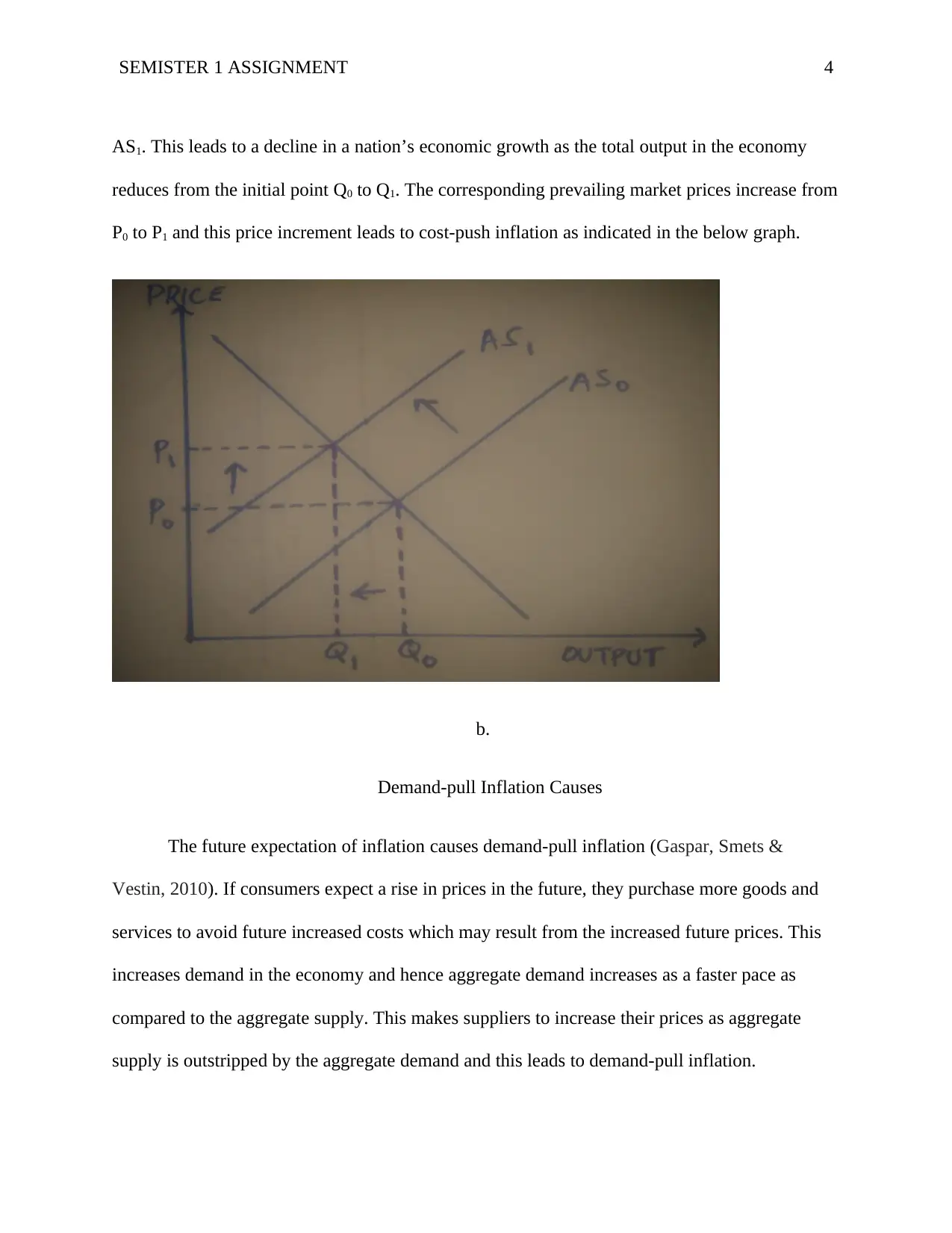
SEMISTER 1 ASSIGNMENT 4
AS1. This leads to a decline in a nation’s economic growth as the total output in the economy
reduces from the initial point Q0 to Q1. The corresponding prevailing market prices increase from
P0 to P1 and this price increment leads to cost-push inflation as indicated in the below graph.
b.
Demand-pull Inflation Causes
The future expectation of inflation causes demand-pull inflation (Gaspar, Smets &
Vestin, 2010). If consumers expect a rise in prices in the future, they purchase more goods and
services to avoid future increased costs which may result from the increased future prices. This
increases demand in the economy and hence aggregate demand increases as a faster pace as
compared to the aggregate supply. This makes suppliers to increase their prices as aggregate
supply is outstripped by the aggregate demand and this leads to demand-pull inflation.
AS1. This leads to a decline in a nation’s economic growth as the total output in the economy
reduces from the initial point Q0 to Q1. The corresponding prevailing market prices increase from
P0 to P1 and this price increment leads to cost-push inflation as indicated in the below graph.
b.
Demand-pull Inflation Causes
The future expectation of inflation causes demand-pull inflation (Gaspar, Smets &
Vestin, 2010). If consumers expect a rise in prices in the future, they purchase more goods and
services to avoid future increased costs which may result from the increased future prices. This
increases demand in the economy and hence aggregate demand increases as a faster pace as
compared to the aggregate supply. This makes suppliers to increase their prices as aggregate
supply is outstripped by the aggregate demand and this leads to demand-pull inflation.
Paraphrase This Document
Need a fresh take? Get an instant paraphrase of this document with our AI Paraphraser
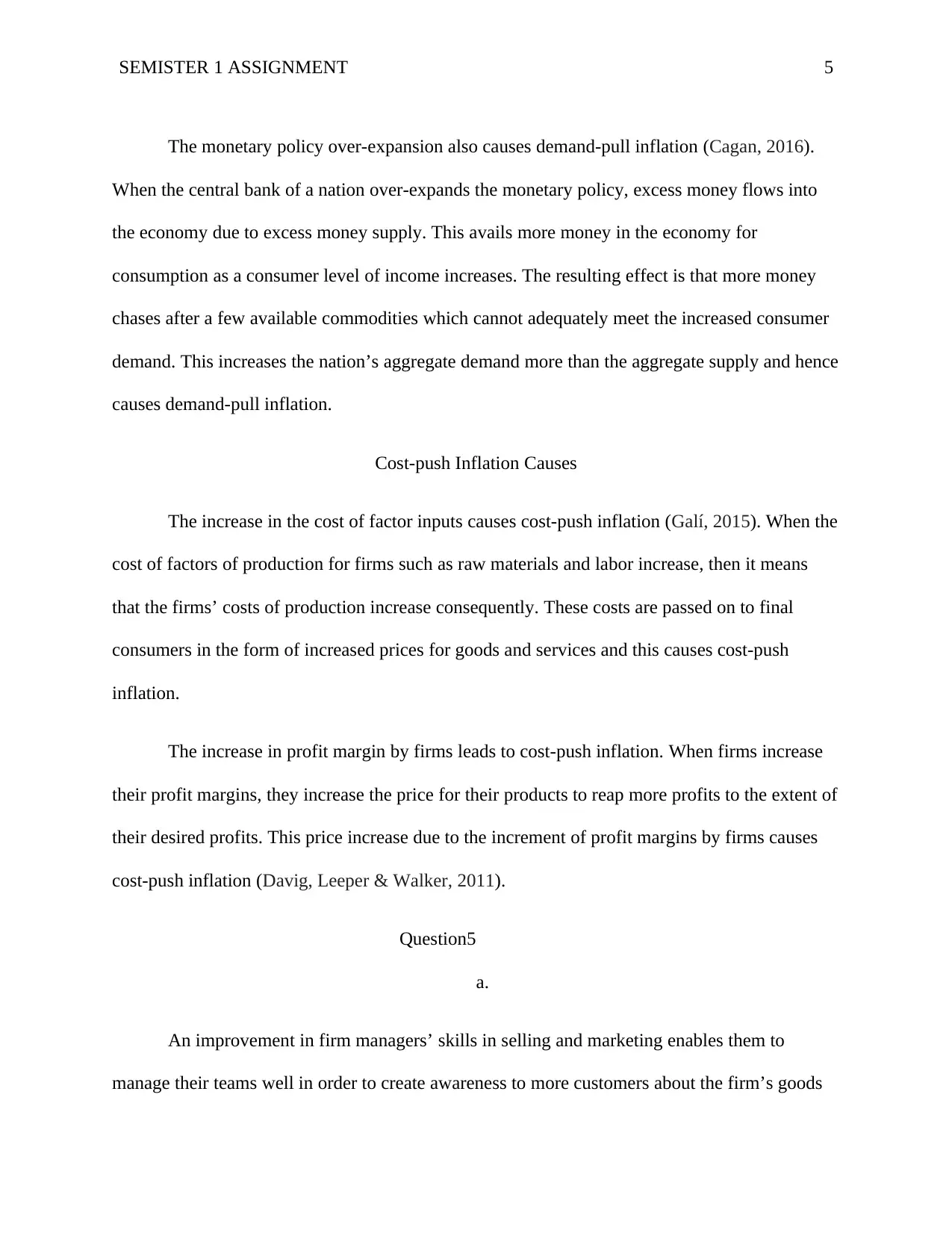
SEMISTER 1 ASSIGNMENT 5
The monetary policy over-expansion also causes demand-pull inflation (Cagan, 2016).
When the central bank of a nation over-expands the monetary policy, excess money flows into
the economy due to excess money supply. This avails more money in the economy for
consumption as a consumer level of income increases. The resulting effect is that more money
chases after a few available commodities which cannot adequately meet the increased consumer
demand. This increases the nation’s aggregate demand more than the aggregate supply and hence
causes demand-pull inflation.
Cost-push Inflation Causes
The increase in the cost of factor inputs causes cost-push inflation (Galí, 2015). When the
cost of factors of production for firms such as raw materials and labor increase, then it means
that the firms’ costs of production increase consequently. These costs are passed on to final
consumers in the form of increased prices for goods and services and this causes cost-push
inflation.
The increase in profit margin by firms leads to cost-push inflation. When firms increase
their profit margins, they increase the price for their products to reap more profits to the extent of
their desired profits. This price increase due to the increment of profit margins by firms causes
cost-push inflation (Davig, Leeper & Walker, 2011).
Question5
a.
An improvement in firm managers’ skills in selling and marketing enables them to
manage their teams well in order to create awareness to more customers about the firm’s goods
The monetary policy over-expansion also causes demand-pull inflation (Cagan, 2016).
When the central bank of a nation over-expands the monetary policy, excess money flows into
the economy due to excess money supply. This avails more money in the economy for
consumption as a consumer level of income increases. The resulting effect is that more money
chases after a few available commodities which cannot adequately meet the increased consumer
demand. This increases the nation’s aggregate demand more than the aggregate supply and hence
causes demand-pull inflation.
Cost-push Inflation Causes
The increase in the cost of factor inputs causes cost-push inflation (Galí, 2015). When the
cost of factors of production for firms such as raw materials and labor increase, then it means
that the firms’ costs of production increase consequently. These costs are passed on to final
consumers in the form of increased prices for goods and services and this causes cost-push
inflation.
The increase in profit margin by firms leads to cost-push inflation. When firms increase
their profit margins, they increase the price for their products to reap more profits to the extent of
their desired profits. This price increase due to the increment of profit margins by firms causes
cost-push inflation (Davig, Leeper & Walker, 2011).
Question5
a.
An improvement in firm managers’ skills in selling and marketing enables them to
manage their teams well in order to create awareness to more customers about the firm’s goods
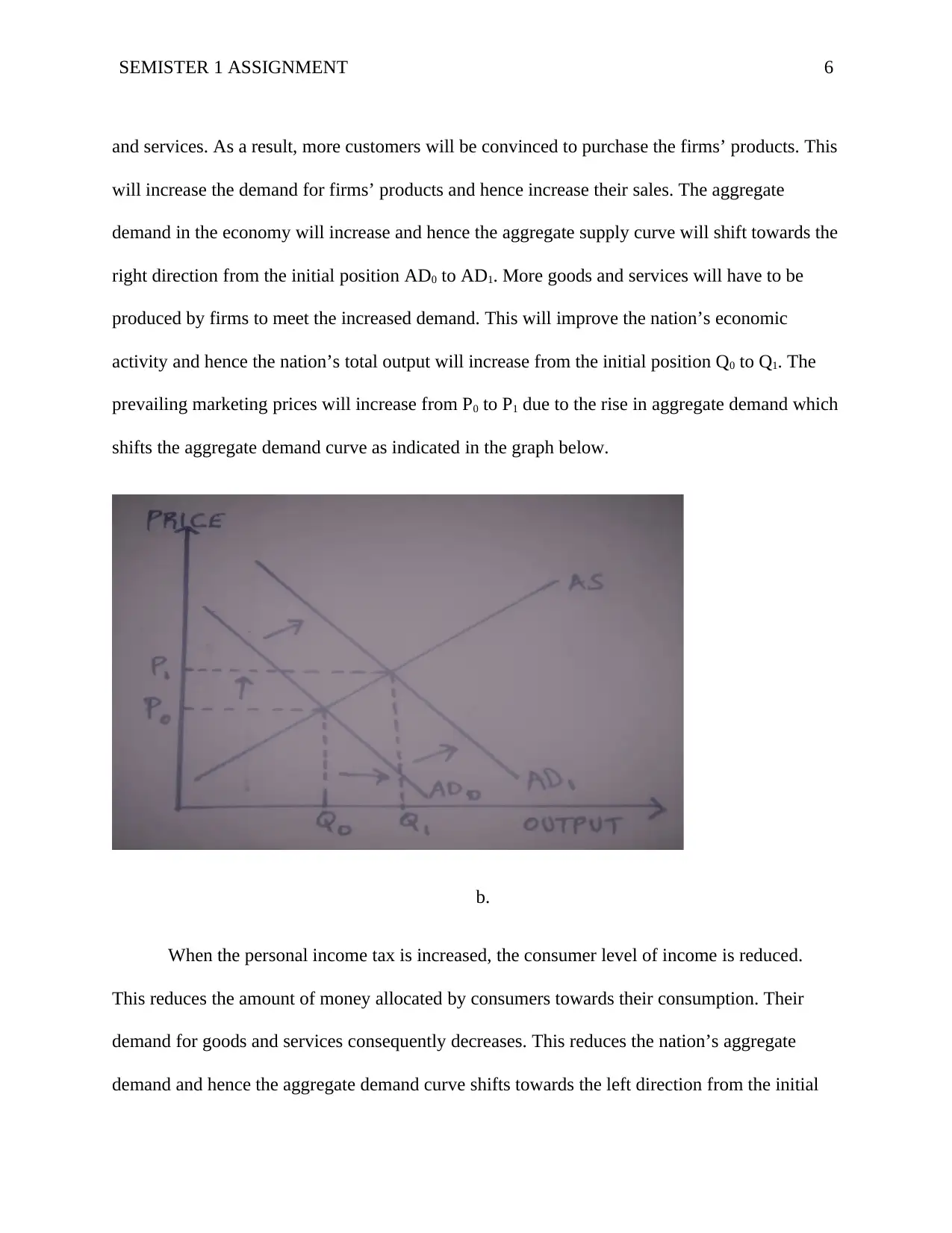
SEMISTER 1 ASSIGNMENT 6
and services. As a result, more customers will be convinced to purchase the firms’ products. This
will increase the demand for firms’ products and hence increase their sales. The aggregate
demand in the economy will increase and hence the aggregate supply curve will shift towards the
right direction from the initial position AD0 to AD1. More goods and services will have to be
produced by firms to meet the increased demand. This will improve the nation’s economic
activity and hence the nation’s total output will increase from the initial position Q0 to Q1. The
prevailing marketing prices will increase from P0 to P1 due to the rise in aggregate demand which
shifts the aggregate demand curve as indicated in the graph below.
b.
When the personal income tax is increased, the consumer level of income is reduced.
This reduces the amount of money allocated by consumers towards their consumption. Their
demand for goods and services consequently decreases. This reduces the nation’s aggregate
demand and hence the aggregate demand curve shifts towards the left direction from the initial
and services. As a result, more customers will be convinced to purchase the firms’ products. This
will increase the demand for firms’ products and hence increase their sales. The aggregate
demand in the economy will increase and hence the aggregate supply curve will shift towards the
right direction from the initial position AD0 to AD1. More goods and services will have to be
produced by firms to meet the increased demand. This will improve the nation’s economic
activity and hence the nation’s total output will increase from the initial position Q0 to Q1. The
prevailing marketing prices will increase from P0 to P1 due to the rise in aggregate demand which
shifts the aggregate demand curve as indicated in the graph below.
b.
When the personal income tax is increased, the consumer level of income is reduced.
This reduces the amount of money allocated by consumers towards their consumption. Their
demand for goods and services consequently decreases. This reduces the nation’s aggregate
demand and hence the aggregate demand curve shifts towards the left direction from the initial
⊘ This is a preview!⊘
Do you want full access?
Subscribe today to unlock all pages.

Trusted by 1+ million students worldwide
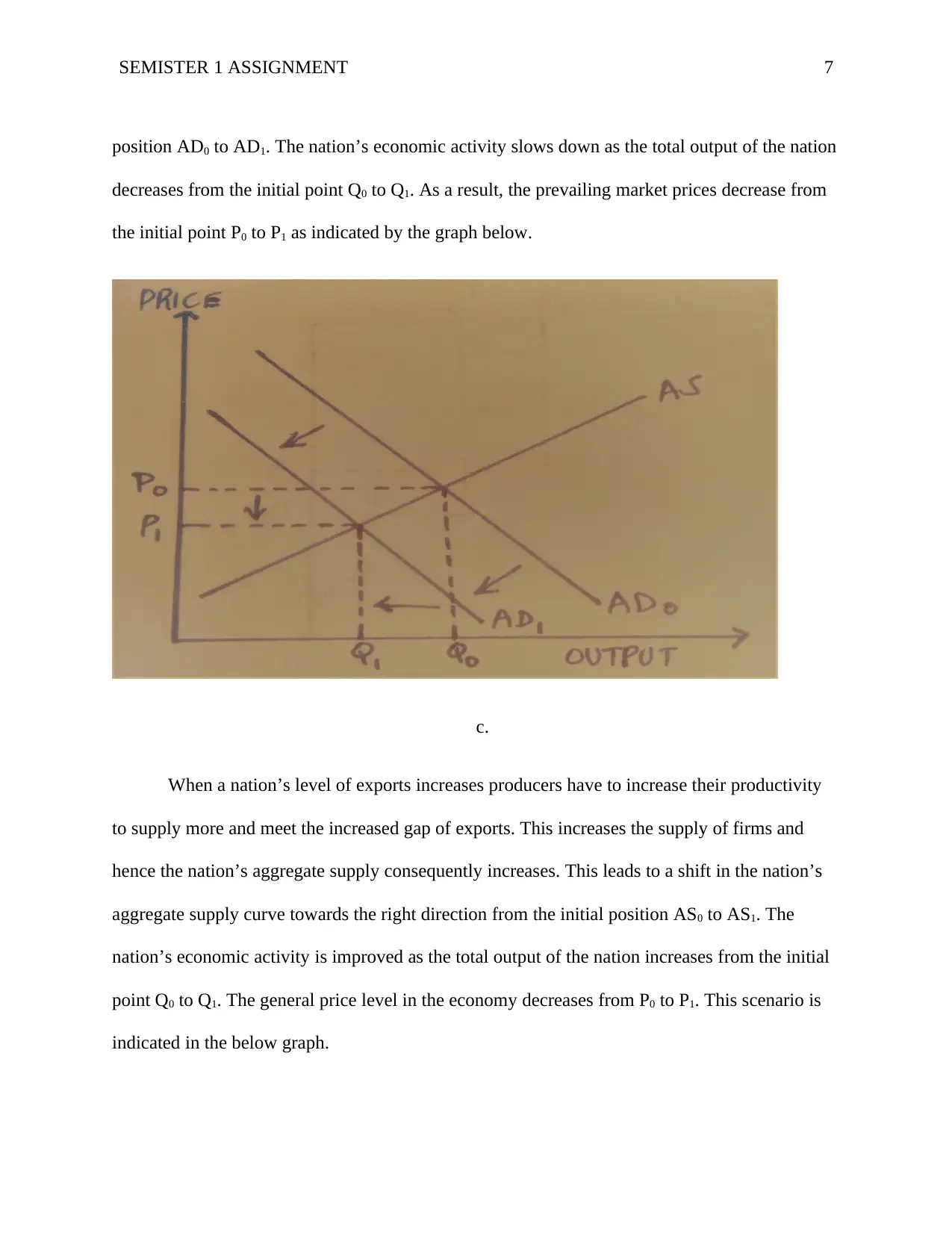
SEMISTER 1 ASSIGNMENT 7
position AD0 to AD1. The nation’s economic activity slows down as the total output of the nation
decreases from the initial point Q0 to Q1. As a result, the prevailing market prices decrease from
the initial point P0 to P1 as indicated by the graph below.
c.
When a nation’s level of exports increases producers have to increase their productivity
to supply more and meet the increased gap of exports. This increases the supply of firms and
hence the nation’s aggregate supply consequently increases. This leads to a shift in the nation’s
aggregate supply curve towards the right direction from the initial position AS0 to AS1. The
nation’s economic activity is improved as the total output of the nation increases from the initial
point Q0 to Q1. The general price level in the economy decreases from P0 to P1. This scenario is
indicated in the below graph.
position AD0 to AD1. The nation’s economic activity slows down as the total output of the nation
decreases from the initial point Q0 to Q1. As a result, the prevailing market prices decrease from
the initial point P0 to P1 as indicated by the graph below.
c.
When a nation’s level of exports increases producers have to increase their productivity
to supply more and meet the increased gap of exports. This increases the supply of firms and
hence the nation’s aggregate supply consequently increases. This leads to a shift in the nation’s
aggregate supply curve towards the right direction from the initial position AS0 to AS1. The
nation’s economic activity is improved as the total output of the nation increases from the initial
point Q0 to Q1. The general price level in the economy decreases from P0 to P1. This scenario is
indicated in the below graph.
Paraphrase This Document
Need a fresh take? Get an instant paraphrase of this document with our AI Paraphraser

SEMISTER 1 ASSIGNMENT 8
d.
The capital stock in an economy refers to assets which aid in production activities such as
equipment, machinery, and plant among others. When the capital stock is destroyed as a result of
war, then it means that the level of production in a nation’s economy decreases as enough capital
stock is not available for sufficient production. This will lead to a decline in supply by firms in
the economy and consequently, the aggregate supply will decrease. This will shift the aggregate
supply curve towards the left direction from the initial position AS0 to AS1. The economic
activity of the nation will decline as the total output in the nation decreases from the initial point
Q0 to Q1. The general prices in the economy will rise from the initial point P0 to P1. This has been
indicated in the diagram below.
d.
The capital stock in an economy refers to assets which aid in production activities such as
equipment, machinery, and plant among others. When the capital stock is destroyed as a result of
war, then it means that the level of production in a nation’s economy decreases as enough capital
stock is not available for sufficient production. This will lead to a decline in supply by firms in
the economy and consequently, the aggregate supply will decrease. This will shift the aggregate
supply curve towards the left direction from the initial position AS0 to AS1. The economic
activity of the nation will decline as the total output in the nation decreases from the initial point
Q0 to Q1. The general prices in the economy will rise from the initial point P0 to P1. This has been
indicated in the diagram below.
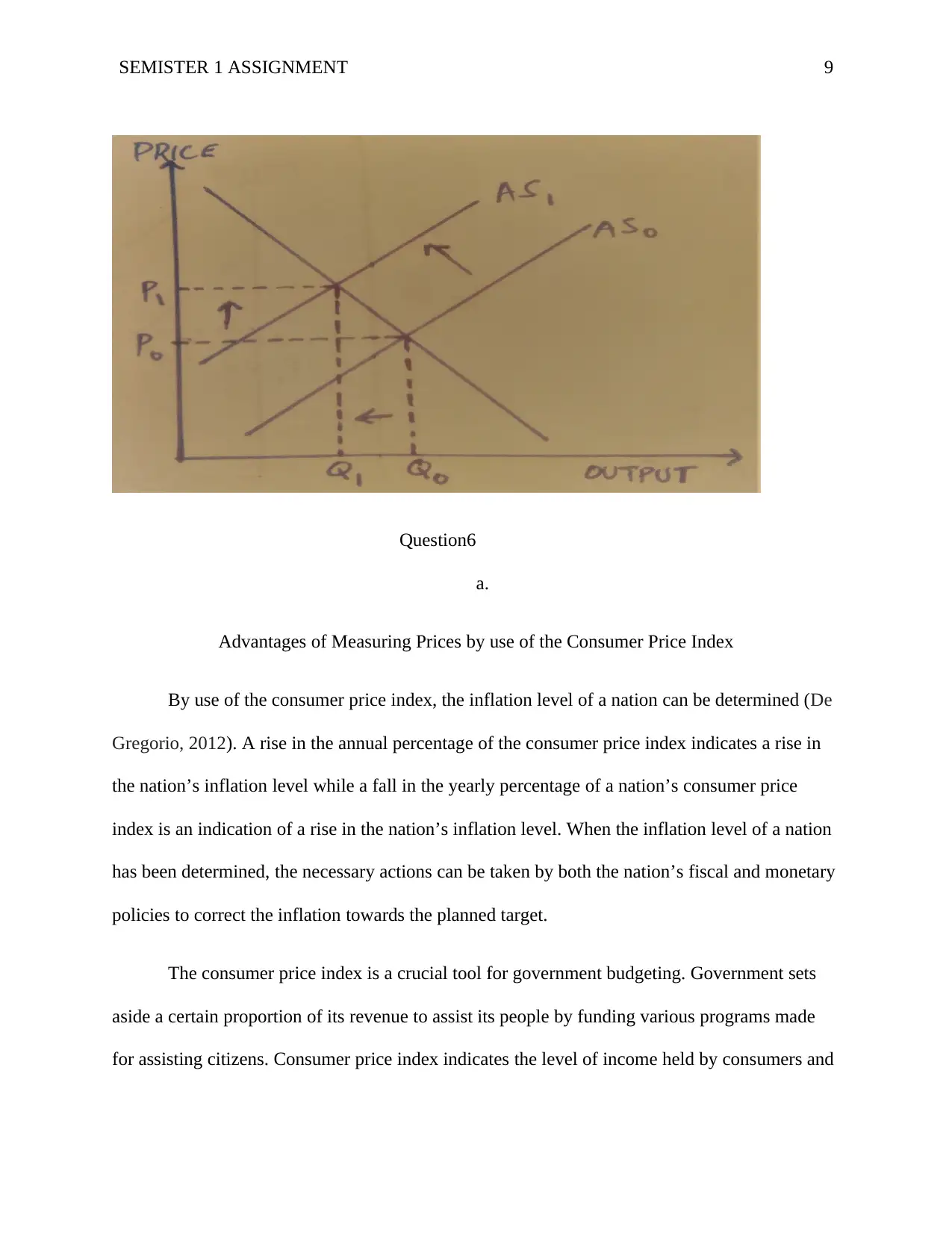
SEMISTER 1 ASSIGNMENT 9
Question6
a.
Advantages of Measuring Prices by use of the Consumer Price Index
By use of the consumer price index, the inflation level of a nation can be determined (De
Gregorio, 2012). A rise in the annual percentage of the consumer price index indicates a rise in
the nation’s inflation level while a fall in the yearly percentage of a nation’s consumer price
index is an indication of a rise in the nation’s inflation level. When the inflation level of a nation
has been determined, the necessary actions can be taken by both the nation’s fiscal and monetary
policies to correct the inflation towards the planned target.
The consumer price index is a crucial tool for government budgeting. Government sets
aside a certain proportion of its revenue to assist its people by funding various programs made
for assisting citizens. Consumer price index indicates the level of income held by consumers and
Question6
a.
Advantages of Measuring Prices by use of the Consumer Price Index
By use of the consumer price index, the inflation level of a nation can be determined (De
Gregorio, 2012). A rise in the annual percentage of the consumer price index indicates a rise in
the nation’s inflation level while a fall in the yearly percentage of a nation’s consumer price
index is an indication of a rise in the nation’s inflation level. When the inflation level of a nation
has been determined, the necessary actions can be taken by both the nation’s fiscal and monetary
policies to correct the inflation towards the planned target.
The consumer price index is a crucial tool for government budgeting. Government sets
aside a certain proportion of its revenue to assist its people by funding various programs made
for assisting citizens. Consumer price index indicates the level of income held by consumers and
⊘ This is a preview!⊘
Do you want full access?
Subscribe today to unlock all pages.

Trusted by 1+ million students worldwide
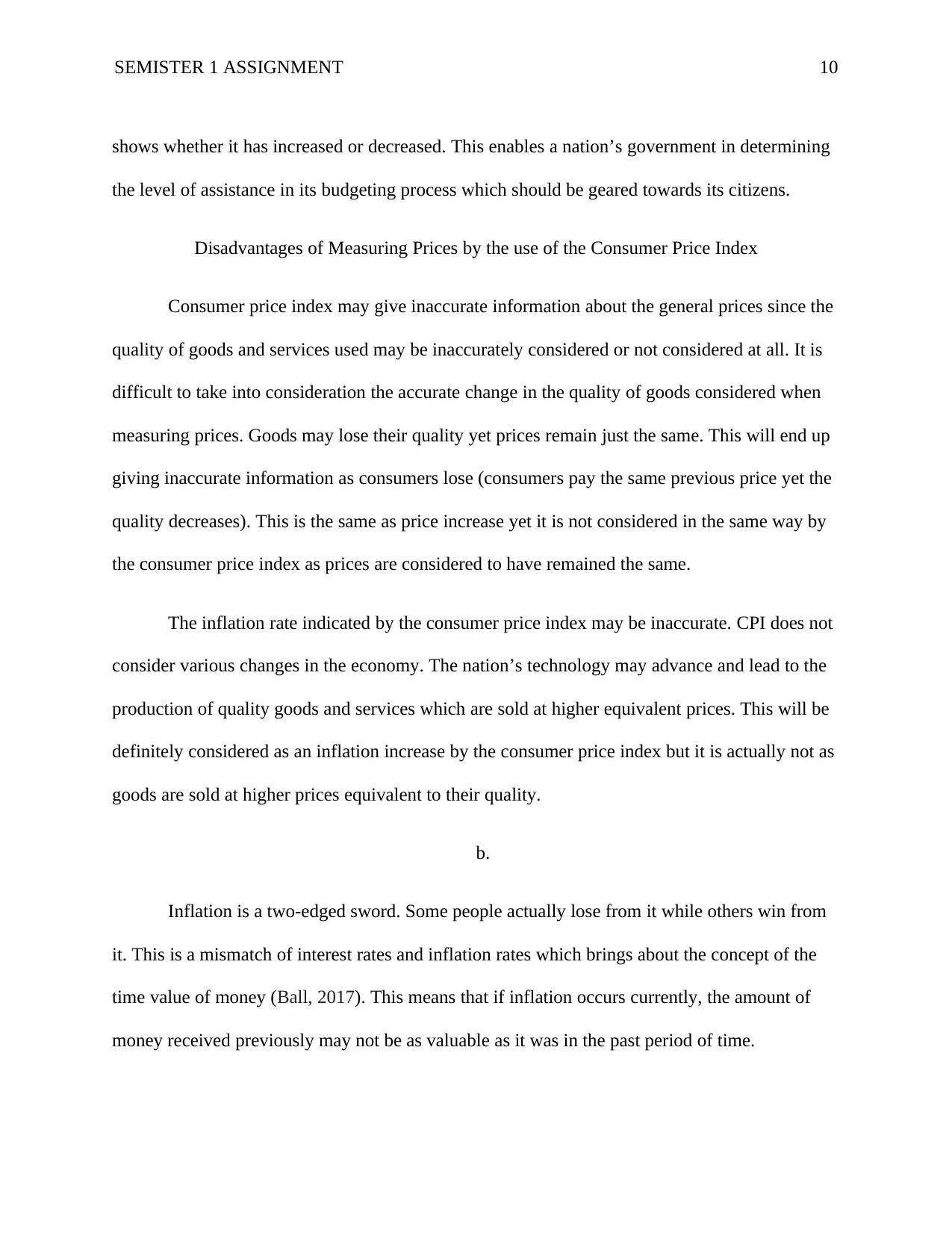
SEMISTER 1 ASSIGNMENT 10
shows whether it has increased or decreased. This enables a nation’s government in determining
the level of assistance in its budgeting process which should be geared towards its citizens.
Disadvantages of Measuring Prices by the use of the Consumer Price Index
Consumer price index may give inaccurate information about the general prices since the
quality of goods and services used may be inaccurately considered or not considered at all. It is
difficult to take into consideration the accurate change in the quality of goods considered when
measuring prices. Goods may lose their quality yet prices remain just the same. This will end up
giving inaccurate information as consumers lose (consumers pay the same previous price yet the
quality decreases). This is the same as price increase yet it is not considered in the same way by
the consumer price index as prices are considered to have remained the same.
The inflation rate indicated by the consumer price index may be inaccurate. CPI does not
consider various changes in the economy. The nation’s technology may advance and lead to the
production of quality goods and services which are sold at higher equivalent prices. This will be
definitely considered as an inflation increase by the consumer price index but it is actually not as
goods are sold at higher prices equivalent to their quality.
b.
Inflation is a two-edged sword. Some people actually lose from it while others win from
it. This is a mismatch of interest rates and inflation rates which brings about the concept of the
time value of money (Ball, 2017). This means that if inflation occurs currently, the amount of
money received previously may not be as valuable as it was in the past period of time.
shows whether it has increased or decreased. This enables a nation’s government in determining
the level of assistance in its budgeting process which should be geared towards its citizens.
Disadvantages of Measuring Prices by the use of the Consumer Price Index
Consumer price index may give inaccurate information about the general prices since the
quality of goods and services used may be inaccurately considered or not considered at all. It is
difficult to take into consideration the accurate change in the quality of goods considered when
measuring prices. Goods may lose their quality yet prices remain just the same. This will end up
giving inaccurate information as consumers lose (consumers pay the same previous price yet the
quality decreases). This is the same as price increase yet it is not considered in the same way by
the consumer price index as prices are considered to have remained the same.
The inflation rate indicated by the consumer price index may be inaccurate. CPI does not
consider various changes in the economy. The nation’s technology may advance and lead to the
production of quality goods and services which are sold at higher equivalent prices. This will be
definitely considered as an inflation increase by the consumer price index but it is actually not as
goods are sold at higher prices equivalent to their quality.
b.
Inflation is a two-edged sword. Some people actually lose from it while others win from
it. This is a mismatch of interest rates and inflation rates which brings about the concept of the
time value of money (Ball, 2017). This means that if inflation occurs currently, the amount of
money received previously may not be as valuable as it was in the past period of time.
Paraphrase This Document
Need a fresh take? Get an instant paraphrase of this document with our AI Paraphraser
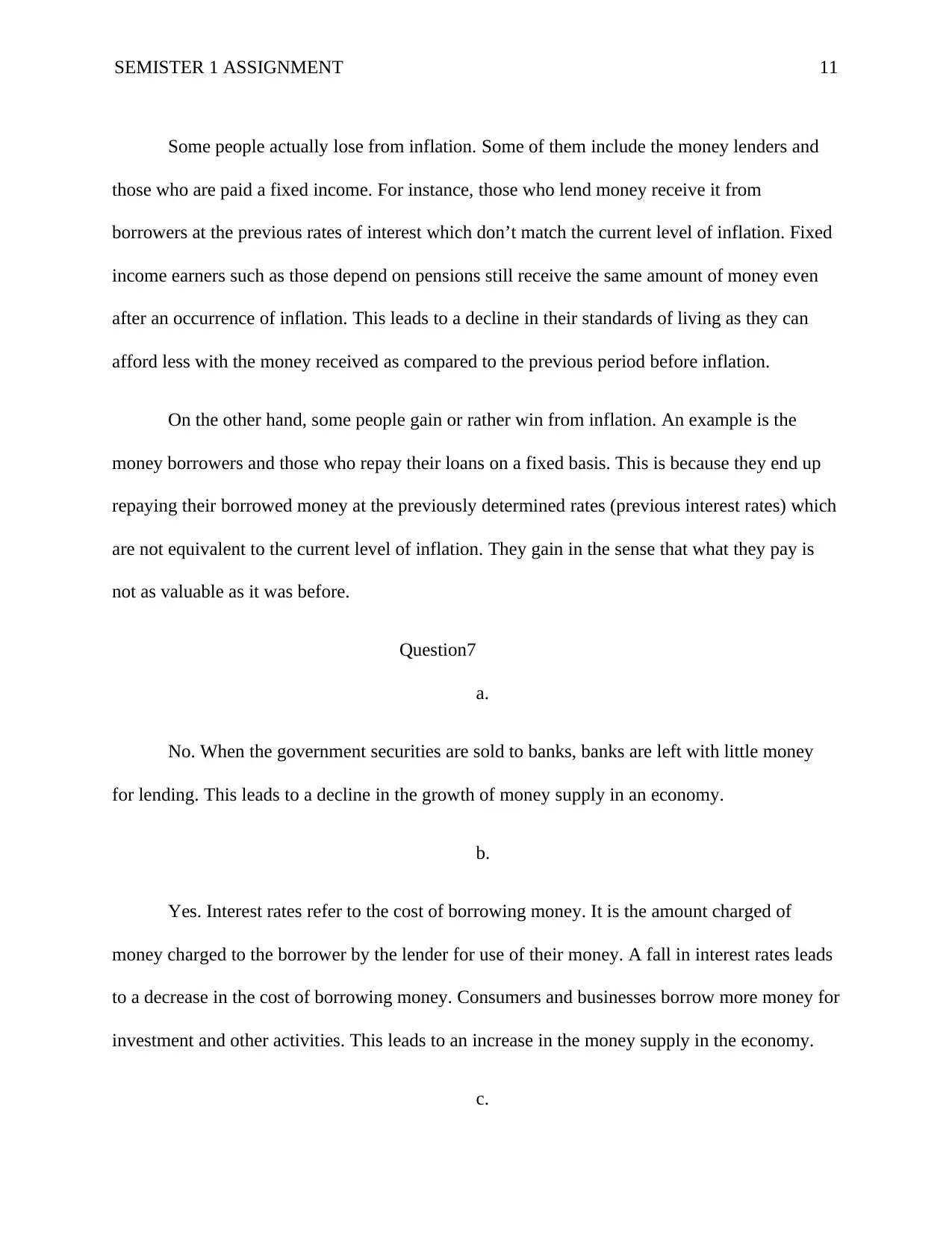
SEMISTER 1 ASSIGNMENT 11
Some people actually lose from inflation. Some of them include the money lenders and
those who are paid a fixed income. For instance, those who lend money receive it from
borrowers at the previous rates of interest which don’t match the current level of inflation. Fixed
income earners such as those depend on pensions still receive the same amount of money even
after an occurrence of inflation. This leads to a decline in their standards of living as they can
afford less with the money received as compared to the previous period before inflation.
On the other hand, some people gain or rather win from inflation. An example is the
money borrowers and those who repay their loans on a fixed basis. This is because they end up
repaying their borrowed money at the previously determined rates (previous interest rates) which
are not equivalent to the current level of inflation. They gain in the sense that what they pay is
not as valuable as it was before.
Question7
a.
No. When the government securities are sold to banks, banks are left with little money
for lending. This leads to a decline in the growth of money supply in an economy.
b.
Yes. Interest rates refer to the cost of borrowing money. It is the amount charged of
money charged to the borrower by the lender for use of their money. A fall in interest rates leads
to a decrease in the cost of borrowing money. Consumers and businesses borrow more money for
investment and other activities. This leads to an increase in the money supply in the economy.
c.
Some people actually lose from inflation. Some of them include the money lenders and
those who are paid a fixed income. For instance, those who lend money receive it from
borrowers at the previous rates of interest which don’t match the current level of inflation. Fixed
income earners such as those depend on pensions still receive the same amount of money even
after an occurrence of inflation. This leads to a decline in their standards of living as they can
afford less with the money received as compared to the previous period before inflation.
On the other hand, some people gain or rather win from inflation. An example is the
money borrowers and those who repay their loans on a fixed basis. This is because they end up
repaying their borrowed money at the previously determined rates (previous interest rates) which
are not equivalent to the current level of inflation. They gain in the sense that what they pay is
not as valuable as it was before.
Question7
a.
No. When the government securities are sold to banks, banks are left with little money
for lending. This leads to a decline in the growth of money supply in an economy.
b.
Yes. Interest rates refer to the cost of borrowing money. It is the amount charged of
money charged to the borrower by the lender for use of their money. A fall in interest rates leads
to a decrease in the cost of borrowing money. Consumers and businesses borrow more money for
investment and other activities. This leads to an increase in the money supply in the economy.
c.
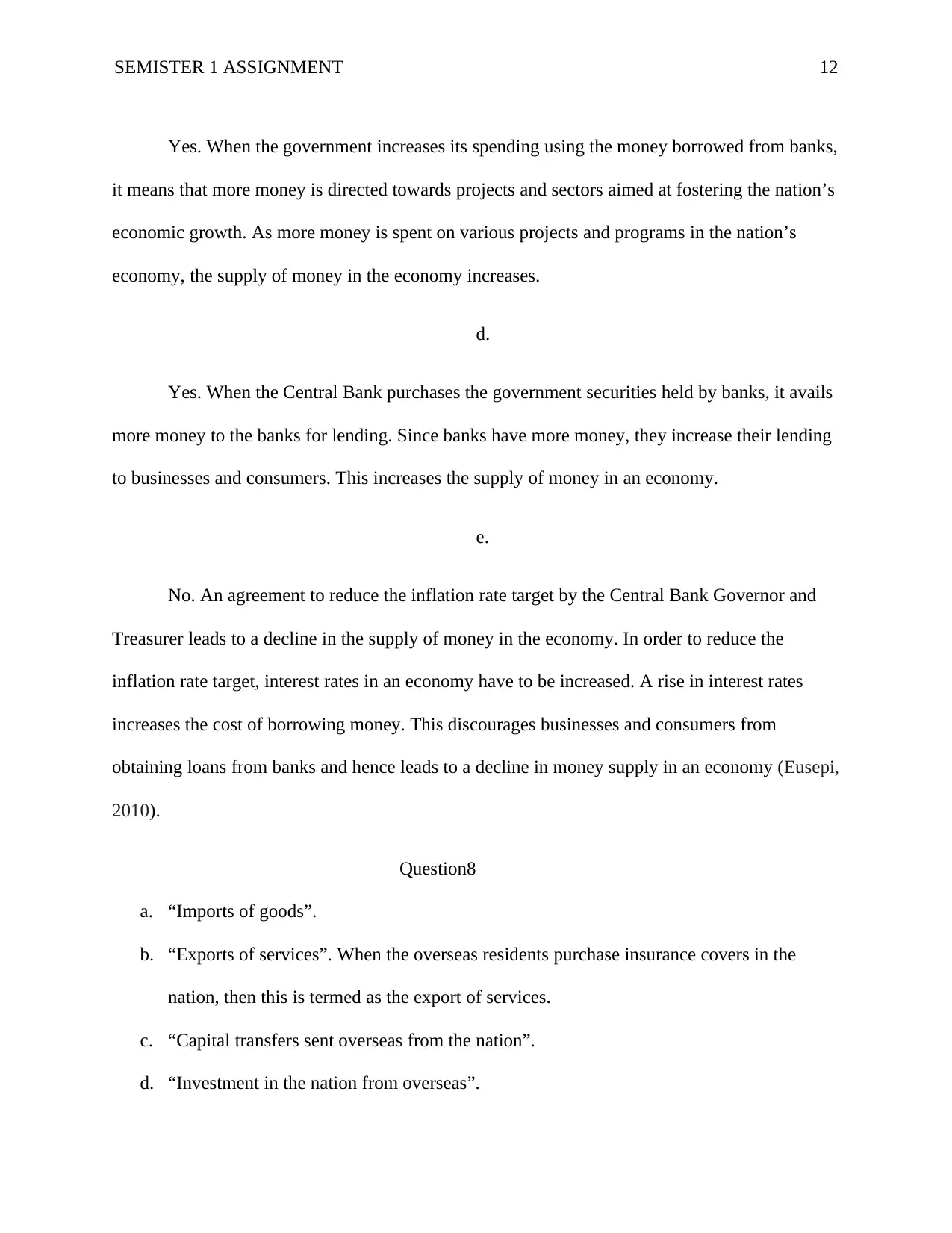
SEMISTER 1 ASSIGNMENT 12
Yes. When the government increases its spending using the money borrowed from banks,
it means that more money is directed towards projects and sectors aimed at fostering the nation’s
economic growth. As more money is spent on various projects and programs in the nation’s
economy, the supply of money in the economy increases.
d.
Yes. When the Central Bank purchases the government securities held by banks, it avails
more money to the banks for lending. Since banks have more money, they increase their lending
to businesses and consumers. This increases the supply of money in an economy.
e.
No. An agreement to reduce the inflation rate target by the Central Bank Governor and
Treasurer leads to a decline in the supply of money in the economy. In order to reduce the
inflation rate target, interest rates in an economy have to be increased. A rise in interest rates
increases the cost of borrowing money. This discourages businesses and consumers from
obtaining loans from banks and hence leads to a decline in money supply in an economy (Eusepi,
2010).
Question8
a. “Imports of goods”.
b. “Exports of services”. When the overseas residents purchase insurance covers in the
nation, then this is termed as the export of services.
c. “Capital transfers sent overseas from the nation”.
d. “Investment in the nation from overseas”.
Yes. When the government increases its spending using the money borrowed from banks,
it means that more money is directed towards projects and sectors aimed at fostering the nation’s
economic growth. As more money is spent on various projects and programs in the nation’s
economy, the supply of money in the economy increases.
d.
Yes. When the Central Bank purchases the government securities held by banks, it avails
more money to the banks for lending. Since banks have more money, they increase their lending
to businesses and consumers. This increases the supply of money in an economy.
e.
No. An agreement to reduce the inflation rate target by the Central Bank Governor and
Treasurer leads to a decline in the supply of money in the economy. In order to reduce the
inflation rate target, interest rates in an economy have to be increased. A rise in interest rates
increases the cost of borrowing money. This discourages businesses and consumers from
obtaining loans from banks and hence leads to a decline in money supply in an economy (Eusepi,
2010).
Question8
a. “Imports of goods”.
b. “Exports of services”. When the overseas residents purchase insurance covers in the
nation, then this is termed as the export of services.
c. “Capital transfers sent overseas from the nation”.
d. “Investment in the nation from overseas”.
⊘ This is a preview!⊘
Do you want full access?
Subscribe today to unlock all pages.

Trusted by 1+ million students worldwide
1 out of 14
Related Documents
Your All-in-One AI-Powered Toolkit for Academic Success.
+13062052269
info@desklib.com
Available 24*7 on WhatsApp / Email
![[object Object]](/_next/static/media/star-bottom.7253800d.svg)
Unlock your academic potential
Copyright © 2020–2025 A2Z Services. All Rights Reserved. Developed and managed by ZUCOL.





